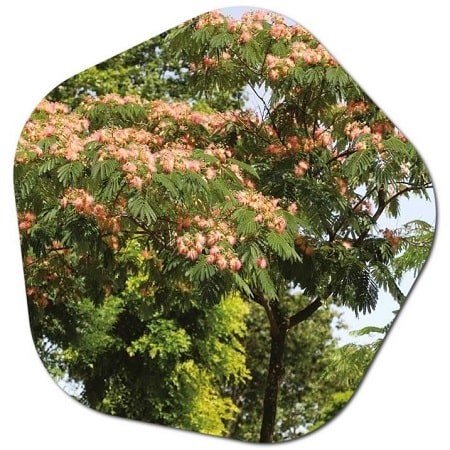Where does Albizia julibrissin come from?
Its homeland is the tropical regions of Asia. They can grow up to 15 m tall. They are deciduous trees or large shrubs or trees with very wide crowns with domes. Although this beautiful plant originates from Asia (Iran), it can withstand temperatures of -15 degrees Celsius. In 1749, this tree was named Albizia abroad in honor of Fiippledel Albizzi, who saw this tree in Istanbul and took it to Florence.
Albizia julibrissin is an antiparasitic, carminative, carminative, anti-inflammatory, diuretic, diuretic, birth accelerator, sedative, stimulant, tonic, antiparasitic and wound healing. It is applied as a poultice on wounds and swellings. Gum obtained from the plant is used in cases of fractures and dislocations.
It grows naturally in tropical regions of Asia and Iran. It is a fine and light textured tree. It is 10-12 m tall and the crown is 6 m wide. It is a spreading and scattered shaped tree. It grows fast. Trunk bark is granular. Its double feathery compound leaves consist of 40-60 leaflets. The flowers blooming in June and July are light pink and fragrant. Pods are 10-20 cm long and grainy. It grows in warm and temperate climates. It likes sunny places, fresh, cool and deep soils, it can also grow in heavy soils. It is sensitive to frost and wind. Used in front gardens, near buildings, parks, solitary or in small groups. It should be brought to places sheltered from the wind.
Where does Albizia julibrissin come from? Albizia julibrissin, commonly known as the Silk Tree or Mimosa Tree, is native to eastern and southwestern Asia. Its natural range includes regions in Iran, China, Korea, and Japan. Over time, it has been introduced and cultivated in many other parts of the world, including North America and Europe, where it is appreciated for its ornamental qualities, such as its distinctive feathery leaves and showy, fragrant flowers. Due to its attractive appearance, it has become a popular landscaping tree in many countries outside its native range.
What is the tree Albizzia julibrissin? Where does it grow?
Albizia julibrissin, commonly known as the Silk Tree or Mimosa Tree, is a deciduous tree native to eastern and southwestern Asia. Here’s some information about this tree and its growth:

Description:
- Albizia julibrissin is a small to medium-sized tree with a spreading, umbrella-like canopy.
- The leaves are bipinnately compound, giving them a fern-like or feathery appearance.
- The tree produces fragrant, pink to pale purple, or white flowers in fluffy, pom-pom-like clusters.
- It is known for its rapid growth and tends to produce an abundance of seed pods, which are often used in decorative crafts.
Habitat and Range:
- The natural range of Albizia julibrissin includes regions in eastern and southwestern Asia, with native populations in Iran, China, Korea, and Japan.
- This tree thrives in a variety of habitats, including open woodlands, disturbed areas, and along riverbanks and roadsides.
Cultivation:
- Albizia julibrissin has been widely cultivated outside its native range for its ornamental qualities, such as its attractive foliage and showy flowers.
- It is often used in landscaping and gardens in many parts of North America, Europe, and other temperate regions.
Invasive Potential:
- In some areas, particularly in the United States, Mimosa Trees are considered invasive, as they can self-sow prolifically and compete with native vegetation. As a result, they are restricted or prohibited in some regions to prevent ecological disruption.
Mimosa Trees are known for their graceful appearance and showy flowers, making them popular ornamental trees. However, their invasive tendencies in some regions have raised concerns, and they are managed or discouraged in areas where they threaten native ecosystems.
What is the English name for Albizia julibrissin?
The English name for Albizia julibrissin is “Silk Tree” or “Mimosa Tree.” These common names are widely used to refer to this tree, which is known for its feathery foliage and showy, fragrant flowers.
Where does the Albizzia julibrissin tree grow?
Albizia julibrissin, commonly known as the Silk Tree or Mimosa Tree, can be found growing in various regions around the world. Here’s where it typically grows:
- Native Range: Albizia julibrissin is native to eastern and southwestern Asia. Its natural range includes countries such as Iran, China, Korea, and Japan.
- Cultivation: Due to its attractive appearance, the Silk Tree has been cultivated and planted in many other parts of the world, including North America, Europe, and other temperate regions.
- Landscaping: It is often used in ornamental landscaping and gardens, particularly in countries with temperate climates. The tree’s feathery foliage and showy flowers make it a popular choice for beautifying outdoor spaces.
- Naturalized: In some regions where it has been introduced, Albizia julibrissin has become naturalized and can be found growing in the wild.
- Invasive Species: While appreciated for its ornamental qualities, the Mimosa Tree can be invasive in certain areas, particularly in the United States. It has the potential to self-sow prolifically and outcompete native vegetation, which has led to concerns about its ecological impact.
The Silk Tree’s adaptability and aesthetic appeal have contributed to its widespread cultivation and presence in various parts of the world, both within and outside its native range. What are the benefits of Albizia julibrissin plant? >>





